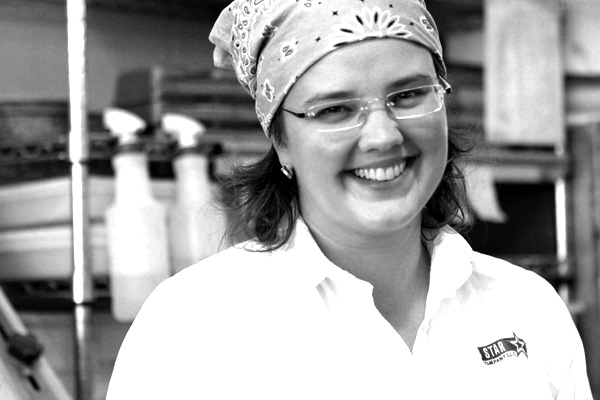
Last year, Solveig Tofte, the head baker at Turtle Bread Company, made food news by taking her locally famous baguettes and sizeable talent off to Paris, France, to compete with The Bread Bakers Guild of America team in the Coupe du Monde de la Boulangerie, an international, invitational artisan baking competition held every three to four years.
In the end, the team — which had trained for two years — took fourth place, narrowly missing third by two-tenths of a point; second by two points. “It was super close,” she says. “On the one hand, that was very gratifying because then I knew that we didn’t totally screw up and just get blown out of the water, on the other it was a maddening head game. I just kept thinking, all that it would have required was for me to scale one more bread accurately, bake it to a better weight, or to have gone over 10 minutes instead of 15 minutes. But, at the end, none of it matters, it is what it is.”
So saying, Tofte has moved on. This summer she launched Sun Street Breads, bringing her own artisanal loaves to the Kingfield Farmers Market. She’s also teaching cooking classes at Turtle Bread, and she’s just been elected to the Guild’s board, where, among other duties, she’ll help develop a training schedule for the new team of bakers.
Here she tells the Heavy Table about her would-be career in weaving, explains why pre-ferments are a pain and a culinary wonder, and defends the Minneapolis food scene and her own sense of contentedness.
When did you start baking?
Baking was a major procrastination tool when I was in college, so instead of doing my homework, I would bake olallieberry scones — it was a William Sonoma cream scone recipe. This was in Santa Cruz. I’d never even heard of an olallieberry, so I felt so exotic and so cool.
The place that I would go to pick had kiwis and ollallieberries and that was like magic to me — kiwis grow on vines!
I was also super inspired by the bakeries in Santa Cruz: Beckmann’s sprouted barley made me want to make bread.
You are always going for your taste memory. You know, I’ll remember something I ate 20 years ago and keep looking for it; I love that part of the experience.
Taste memory?
I always think of my job as a baker as trying to capture taste memories. You just can’t nail that thing for everybody, so I always come as close as I can to my ideal and hope it works for everybody. But the best part of teaching is that I always hope to give people the tools to capture their own taste memories. So I can show you my ideal chocolate chip cookies, but then I can tell you how to make one that’s more soft, crispy, or chewy.
I think that’s the coolest set of tools — to be able to make whatever you want, however you want.
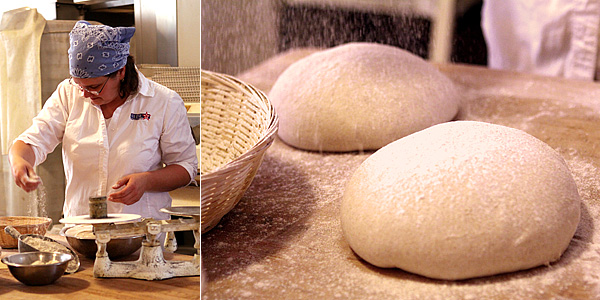
That kind of comes down to science, right?
And that’s my favorite part about baking. Well, there are so many facets to baking — just kind of the efficiency stuff and how you run your day — but the science of it is super interesting. I think that when people have failed attempts at baking, it’s just poorly written recipes and not knowing how things interact; if you know just a few things in a certain category, you can usually figure out how to make sure what you want to happen happens.
So, how did you get back to Minneapolis?
I graduated from Santa Cruz with a degree in American lit, which is why I work in food service. After that, I went to Norway to weave and then moved to Berkeley, where I had about 10,000 jobs.
Can you go back to weaving in Norway?
I went to Norway for half a year of folk school. It is very traditional for Norwegian kids to go there after high school. It’s a year, you don’t get credit; it’s just kind of a time to leave home and learn something that interests you.
I went over for weaving. There weren’t any high school students in the class, it was all these just lovely old women from the town and they’d come over and weave hardcore traditional Norwegian patterns everyday. Since I was a foreign kid, they were always taking me home and feeding me.
The kids spoke better English than I do, so they didn’t have the patience for my Norwegian, but the women would only speak Norwegian. At the end of the term my parents came over — there was a little show — and all the sudden these women started speaking English. After all my struggling…
So then, I thought I’d be a weaver, because I wanted a trade, you know, some kind of job I could move around with, but there are no real weaving jobs.
I’m not a very good visual artist, but I really like the structured, technical side, so I thought textile restoration would be good, but the only place you can do that is England, and then there is just one Tibetan prayer flag a year. You know, it just was not a practical choice.
So, there you were in Berkeley …
I was working a million jobs in Berkeley, just basically answering any ad in the paper and getting pay-the-rent kind of jobs.
My first professional baking job was at Sconehenge. It was in a warehouse with two other food producers — a cheesecake place and knish place. It was three shifts, all men, so walking in they just did not know what to do with a woman. I had to go and audition for the job; the audition was standing there sifting flour on to the table to make sure that I could get an even coverage. Seriously. After I had accomplished that, he said: “Oh, and it’s a good thing, I thought you were too short to reach the table, I had a milk crate over here for you.”
But it was a fun job, after we got over that initial ice-breaking moment. And then I went to baking school at The California Culinary Academy, in 1999.
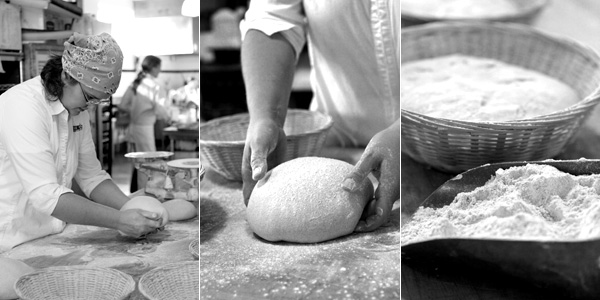
At what point did you come back to the Midwest?
Well, after culinary school we had to get out of the Bay Area. It was too hard to make a living — at the time, our roommates were leaving, we were going to have to move into a tiny, horrible apartment, and we just decided to move back here.
I got the job at Turtle before I moved. I asked my friends and family what was a good bakery, sent pictures of my sourdough and multi-grain breads — you know, geeky cross-sections of the bread and the crumb — and got the job. It was the holidays; if I’d tried that in January it probably wouldn’t have worked out.
I started here 10 years ago today.
And how has it been?
Harvey’s been amazing. He’s taken a lot of chances on me, but the best thing about Harvey is that he gets me to do things that I’m not super comfortable doing. If I’m freaked out, he’ll back off for a while, but he’ll keep coming back with it until I accept the challenge.
So the question always comes up, especially when I started the farmers market stand this summer, “When are you going to open your own bakery?” Right now I’m super happy with everything I’m able to do: I really like my job, I love the people I work with — and I have time to spend with my family and friends, which is incredible. I kind of don’t want to screw it up.
And also, working with the Turtle, I have these super cool opportunities. I have to make this gingerbread house for the Minnesota Landscape Arboretum next week. If I had been my own little random shop somewhere, I don’t know if they would have called me, but Turtle has been around for 15 years, so they contacted us.
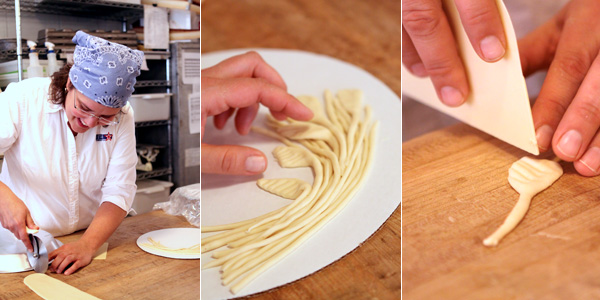
So you’re making a house?
Yes, but it’s big — I’m just so nervous. I’m doing a classic south Minneapolis house with a little sunroom off to the side. I baked these pine tree shapes, poked holes in the back and got those mini lights with the battery packs, so that’s going to be the Christmas tree in the house.
We always went to the arboretum when I was a kid. We’d visit the hosta glen; I always thought, “Why are we looking at leaves in the ground?” But now I’m trying to make an homage, so I have all these gum paste winter hostas to put in the back in the garden, plus a little wood-fired oven and some tiny pizzas.
How’s the baking scene in Minneapolis? Is there anything you would change?
Yes, I really wish I could make walnut, cocoa-nib bread and have it sell. You can’t sell everything, everywhere you go, so I don’t feel thwarted or anything — but you do have to figure out what they will buy and make it.
There’s a world of creativity in that — and there are tons of great concepts I’d like to try here.
In San Francisco, I ate at this place called Kitchenette SF. It’s down in Dogpatch, in the warehouse district. Basically, a bunch of caterers get together and offer lunch. They have one sandwich, one drink, one salad, and one cookie. It’s off the dock of a warehouse; they just roll up the door, there’s some stairs up the side, and you go order what you want.
Seriously, that was the best sandwich I’ve had in – well, ever maybe. My friend and I went and sat on the curb and ate, and this big, giant truck driver pulls up and says, “What’s the sandwich today?”
It was awesome, I’m sitting there eating the most fancy sandwich — it was like green-garlic mayo, skirt steak, amazing bread, arugula, avocado — you know, it was a pretty high-brow sandwich, and super trucker driver was like, “All right, I’m going in!”
I think a concept like that might work somewhere like the Northrup King Building, where you have a captive, walking audience.
Thing about Minneapolis is, it’s a small city and that’s what makes it awesome, so when everybody gets so bent out of shape about how we don’t have x, y, or z like New York, I’m like, well, we have a tiny percentage of those populations and we live differently. In San Francisco, nobody has a car and, with the bus, you typically have to get off and walk a few blocks, and you’re going to pass the grocery store or taqueria and pick up a little food and be on your way. But here, we are less inclined to drive to a place for one sandwich and find that it’s not something we like.

How is the bread you’re making for Sun Street different than what you do for Turtle?
The breads that I’m doing for Sun Street are more complicated because of the pre-ferments. At Turtle, the day before we make the bread, we make a ton of pre-ferment, poolish and sourdough starters mainly.
The mixing shift is the most exhausting; it’s the most lifting. One time, I calculated that I lifted like 5,000 pounds over the course of the evening just getting the ingredients in and out of the mixer, moving all the buckets… So you’re tired, you want to go home, and you have to mix all of the stuff for the next day.
So, like most bakeries, we all typically only do one or two things for a certain loaf. For the sunflower rye, we do two things — a rye levain and a sunflower-seed soaker — but that’s pretty much the max.
For Sun Street, I have two or three pre-ferments. I don’t think it is entirely necessary, but it’s what I love about breads.
If you pre-ferment equal parts semolina and water and yeast, you get this kind of cool buttery flavor. A rye sponge has a very clean spicy flavor. So you can marry those two in one loaf and have this bread with a very kind of haunting rye and buttery semolina flavor… it’s esoteric and fun for me.
It sounds complex and cost-prohibitive… I guess we won’t be able to convince you to make that potato-flax bread at Turtle?
I might, but it has too much stuff; I’d have to simplify it. I do have 45 pounds of flax seed to use up, so I need to do some kind of flax bread. But my life right now is pies, pies, pies.
Why Sun Street?
That’s what my name means in Norwegian. It’s a goofy direct translation, but I had a bunch of friends over there call me a Sun Street. It is happy, you know, Sun Street is a nice place to live. There’s a bunch of translations: I always grew up thinking it was sunshine, but the one I found more recently is haus frau, so I am going to stick to Sun Street. Plus, the domain was available.
Will you be back at the Kingfield Farmers Market next year?
I’ll definitely do it again, if they’ll have me. We live a block away, so it’s like a big party, folks come by and say hi, and my husband and daughter work there. My daughter just loved it — she is five. The other day I asked her, “Guess what tomorrow is?” She said, “It’s Sunday! It’s farmers market day!” That warmed my heart.
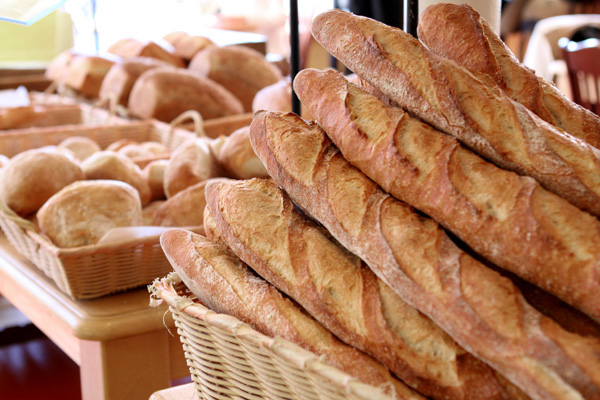
I’ve read that you love bakers – in part for their dedication – but you call shenanigans on passion; can you talk about that?
There’s a huge romance and around baking. When people ask me what I do and I say, I’m a baker, they think I’m a banker, so we go through that whole thing, then they say, “Oh that’s so wonderful that you work with hands.”
I happen to derive a lot of pleasure from baking, but the magic isn’t in working with my hands, it’s a very mental job.
People will come in and work for a day; maybe they think they want a job. We go through that that thing: It’s so amazing to make a perfect baguette, but when you have to make 200 in the time it took you to do the one, you have to embrace the production side of it, you have to love cranking things out. There are a lot of unglamorous jobs, like scooping cookies, which can be completely enjoyable if you can find the headspace. When people go into baking with a romantic, nostalgic idea of it, they are missing a huge chance to find some love in work.
Will you compete in the Coupe du Monde de la Boulangerie again?
No, I did the competition because I wanted to work with those guys. These were all my idols, I had learned so much from them already, and I so wanted the chance to learn more, and so that’s why this particular competition was my goal — it was great, I worked with so many different people, learned so many tricks, and really fine-tuned a lot of things.
Now, this summer, baking for the farmers market, there were just so many times that I surprised myself. It’s a physical, mechanical job and there are just so many things your body just knows to do, without thinking about it. With my day-to-day work at Turtle I don’t work many bread shifts, so I would just be doing something and get to the end and be like, “Wow, how did I even know how to do that?”
Doing all that stuff was a big confidence boost. Not that I’m the best baker in the world, but that I can apply my head and body to a task and accomplish it — that was the best part. Setting up the stand at the farmers market, I knew I could bake what I needed to in a night, and go set up and stand and see if it sold; if it did great and if it didn’t it wasn’t going to be the end of me.
How are you enjoying teaching?
This past summer, I was feeling kind of bored — after working so hard for two years, there was a big hole in my life and I had kind of forgotten what I used to fill it with. I always feel like boredom is kind of your own fault, figure out what you need to do to get yourself excited and interested again. So I thought teaching would be fun, and it has been amazing.
All the people that come into take these classes at Turtle are funny, we chat a lot. It’s great teaching at the shop because it’s my home turf and I have these giant ovens. We can make a ton of things.
When I was trying to bake as a kid, I sucked. It was horrible. I was poor, but I would go buy expensive ingredients — chocolate and butter — and then it wouldn’t work and I would get so mad.
I take teaching home bakers seriously. I test all my formulas at home. There are so many under-tested recipes out there. So people have these disasters and think, I can only cook, you have to be too precise with baking. I want to show everybody that it’s not scary; it’s actually pretty fun.
Any parting advice for home bakers?
I always tell people, pick one basic bread recipe — flour, water, salt, yeast — and make it over and over again until you nail it. You can learn so much from how the dough feels. That’s something instructors don’t always touch on with new bakers.
The recipes always say to let it rise until it’s double in size. Sometimes, that’s not going to happen — you didn’t knead, the gluten didn’t develop, crazy flour — there are too many factors to rely on a visual.
So, you make a bread over and over, you learn to feel when it’s kneaded enough, when it’s ready to go in oven. You make it until it is awesome, then you branch out.

So is Sun Street dormant till Kingfield reopens or is there bread now? thanks for a great story
Hi Artsy,
Yes, Sun Street Bread is dormant until the farmers market starts up again — thanks for a good question!
Great article. Glad to catch up on what you’re doing.
A great article! It’s so nice to read about how you got to where you are now.
I’m wondering if you would suggest a solid flour that a budding home artisan baker can use to get great results. I mainly make sourdough and multi grain breads. I have used All Trumps and like the color and flavor and also GM’s Better For Bread seems to deliver a good product. The color in your baguettes photo is perfect. This is what I am trying to replicate. There is so much talk about French flours and ash content, malt and such. I would love to hear what you have to say on this subject.
Thank you,
Eric
Eric H – Flour is a huge topic and I’m not sure where to start. I’ve had great results at home with King Arthur (which is spendy), but I mainly use Dakota Maid Bread Flour (which is not spendy at all). The color of the crust is hugely dependent on your fermentation – and that’s a very broad issue.
If you send an email to sol[at]turtlebread.com I can maybe help you more, I can maybe look at your formulas/methods to help with some trouble-shooting. I think I’ll be teaching a basic breads class in January, let me know if you want to get on the list to be notified when that’s posted.
And finally, the Bread Bakers Guild of America is the most amazing resource – we have a ton of home bakers and joining gives you access to a chat room full of very smart bakers, years of newsletters with technical articles, classes, and the Team formulas. The members of this group have taught me everything I know.
I have been a home baker since 1976. I started with Challah and made it over and over year in and year out. I still make it more than all the other breads put together. Due to all the baking and cooking in our home it rubbed of and my oldest son went to NECI and he and his wife are now at Blackberry Farm working. Your daughter will be so blessed to be in your presence and share in the joy you show for your baking. I wish I was not so far in the South, I would love to take a class or two with you.Maybe some day. I loved reading the interview and seeing the great pics. c
Great article, congrats on even going to the Coupe du Monde. I too am a homebaker doing mostly sourdoughs and multigrains. I have used Gold Medal – Better for bread, KA, and just recently trying Dakota Maid and have been very happy with color and taste. I am 300 mi. north but would love to come down and learn more especialy shaping techniques. I enjoy the flavor Roin Hood multigrain flour adds but have only been able to find it in Canada. Have you ever used it?
Steve
Caroline – Congrats on raising a kid with good taste! My daughter is becoming an expert at rolling out samosa dough (that’s been an obsession in the house lately) and the best part is that she would never eat a samosa if it just showed up on a plate, but having had a hand in the creation she’s all for it.
Steve King – I haven’t used Robin Hood multi flour, or really any blended flours for that matter. I have a hand-cranked flour mill and have made my own flours with other grains, but I’m a little control-freaky with my breads and like being able to decide which flours and amounts to use…I do use many multigrain mixes (typically a hot cereal mix, ground rather coarsely) in soakers, that’s a great boost of flavor and texture and the soaking helps get rid of the saw-dust effect common to multigrain breads, and helps ensure the dry grains aren’t robbing your dough of much-needed water.
Great article. I look forward to seeing you at Kingfield Farmers Market next summer.
My mom is a baker of artisanal breads. Any gift ideas for bakers? (She would love your potato flax bread!)
Great article. I look forward to seeing you at Kingfield Farmers Market next summer.
My mom is a baker of artisanal breads. Any gift ideas for bakers? (She would love your potato flax bread!)
Solveig
You mentioned you use Dakota Maid Bread flour, I remember reading that the difference between their bread flour and their AP was not protein but ash content. Do you have any thoughts on the difference between their AP and Bread flours as far as final results?
Steve King